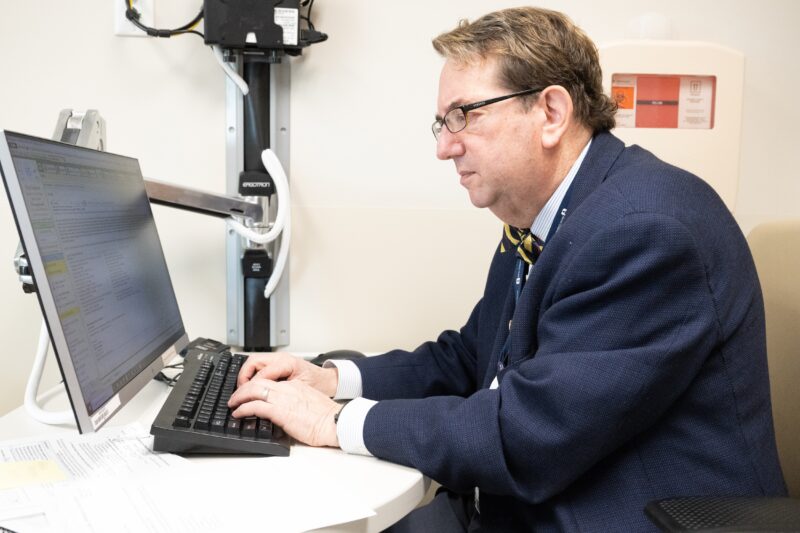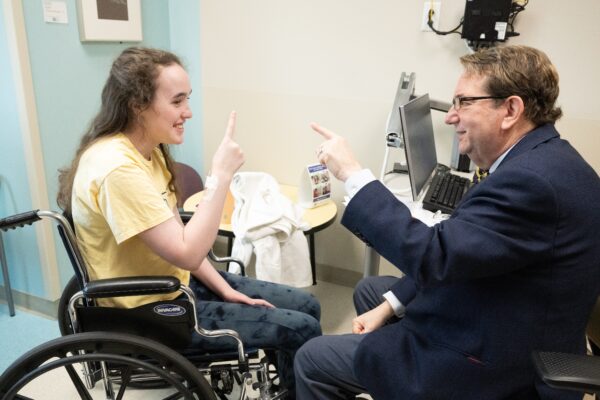
Akron Children’s Dr. Bruce Cohen is considered one of the world’s leading experts in mitochondrial diseases thanks to his dedication to uncover treatments for patients.
In 2011, Bruce Cohen, MD, joined Akron Children’s to open a program and pursue work in clinical trials to advance mitochondrial medicine at a time when funding for this research was in its infancy.
“Frankly, a lot of the large institutions weren’t interested in studying these diseases,” he said. “It wasn’t because it wasn’t important, it was because the number of patients is pretty small and the economics of performing these trials just didn’t meet organizations’ bottom lines.”
But Akron Children’s had an interest — and a promise to treat every child as it would its own and to turn no child away — and it’s been a great ride for more than a decade. Today, Dr. Cohen is considered one of the world’s leading experts in mitochondrial diseases thanks to his dedication and institutional support to uncover treatments for patients.
As Akron Children’s director of the Neurodevelopmental Science Center; director of the Mitochondrial Center of Excellence; and director of Scientific Affairs and Clinical Trials within the Rebecca D. Considine Research Institute, Dr. Cohen’s clinical practice is centered on caring for children and adults with mitochondrial disorders, neurogenetic illness and brain tumors, in addition to a busy clinical research practice to continue his work in advancing patient care in this area.
Akron Children’s Chief Academic Officer and Endowed Chair of the Research Institute Michael Forbes, MD, sat down with Dr. Cohen to discuss his roles here at Akron Children’s, how far treatment for these rare, life-threatening diseases have come since more than a decade ago and what he hopes for the future of mitochondrial medicine.
Dr. Forbes: You’re the director of Mitochondrial Center of Excellence. What does that mean?
Dr. Cohen: The Mitochondrial Center of Excellence allows us to create a mini service line to provide care for patients with rare mitochondrial diseases. It enables physicians, geneticists and genetic counselors, nursing care and a patient navigator to work together to make it easier for patients to receive care here.
Dr. Forbes: Why study mitochondrial disease if it’s so rare?
Dr. Cohen: The ravages of the process of aging are very similar to the ravages of mitochondrial disease. As we better understand how to take care of mitochondrial disease, we better understand how to take care of diseases like Alzheimer’s, diabetes, even heart attacks and strokes.
The mitochondria are the engines of our cells. The more you drive a car engine, the older it gets and starts to wear out. Under the conditions of heat, the constant banging every time the piston goes up and down on the cylinder, and the fact that the byproducts of combusting octane gasoline into water and carbon dioxide create acidic rust, and all these processes create wear and tear on a car engine. The process of aging is similar as it creates wear and tear on the mitochondria and the DNA within it, so that mitochondria can’t replicate itself properly.
When we look at causes of diseases like diabetes, cancer and possibly even long COVID, it comes down to the mitochondria just don’t seem to be working properly. For example, we’re finding commonalities and possibly even treatment options in cancer that may be applicable to some mitochondrial diseases.
Dr. Forbes: So, there are infinite numbers of tie-ins because all our cells have mitochondria.
Dr. Cohen: That’s right. There are a thousand genes that control and regulate the mitochondria. Mutations in any of those genes can potentially cause mitochondrial failure, which can appear in infancy, during the teenage years or even in 40 year olds. If you have one of those mutations, it’s going to manifest itself sometime in your life. It’s one of the things that we all share as we get older.
Dr. Forbes: Let’s take a step back. How did you get involved in this area of interest?
Dr. Cohen: I met my first patient with a mitochondrial disease as an intern. We’re talking about the late winter of 1982 or 3, and I took care of that little girl throughout her life, which she lived to be about 13 years old.
I did my pediatric training and later a fellowship in pediatric brain tumors at Children’s Hospital of Philadelphia. It is this program where I got bitten by the research bug. The standard of care at that hospital was that everyone goes on a clinical trial, if available and the family gives consent.
There was no such thing as a mitochondrial fellowship back then because it’s so rare. We’re talking about probably about one in 10,000 people have a genetic mitochondrial disease, whereas brain tumors occur in about one in 2,000 children. I loved the science of and the compassion of taking care of kids with brain tumors. So, I decided to do a fellowship, and it was the focus of my research career for the first 20 years post-fellowship until I later transitioned to the emerging field of mitochondrial medicine.
Dr. Forbes: What does your role entail as director of Akron Children’s Rebecca D. Considine Research Institute?
Dr. Cohen: One of my passions, and this goes back almost 40 years when I got hooked on it during my training, is clinical trials. Taking patients through a journey where they’re receiving either new drugs to treat their disease or they’re trying to compare a new drug versus a standard therapy to treat their disease is much of what I’ve done throughout my career.
We take groups of patients, with their individual consent, through a journey that may make their outcome better than what would have been had they received the standard therapy for their illness.
Dr. Forbes: I think folks do understand the value of science, but I think there’s still some fear about actually participating in a clinical trial. What are some reasons why the public might want to be more involved in clinical trials?
Dr. Cohen: Sure. I think the best way to answer that is to use a real-life situation. There was a girl in my grade school that got childhood leukemia, and she died within a few months of her diagnosis. Unfortunately, back then, that was a common theme.
Then in high school, one of my close friends developed a brain tumor and died from it within about six months.
Clinical trials get us to that state, for example, where children don’t survive leukemia to iterations and improvements in treatment that lead to long-term survival. While a clinical trial won’t benefit all participants, it has the opportunity — maybe the only opportunity — to benefit some patients and many future patients.
Today, when you look at outcomes for childhood leukemia and some malignant brain tumors, it’s a different ballgame. Many forms of childhood leukemia are now highly treatable and curable. We still have work to do for those 20 to 25% of children that don’t do well with leukemia, but it’s not like it was 40 or 50 years ago when most patients didn’t do well.
Dr. Forbes: As you navigate these 3 hats that you wear, talk a little bit about what brings you joy.

Dr. Cohen’s clinical practice is centered on caring for children and adults with mitochondrial disorders, neurogenetic illness and brain tumors. He also leads a busy clinical research practice to continue his work in advancing patient care in this area.
Dr. Cohen: I should start by saying working with patients and colleagues that I met when I moved to the area in 1989 brings me so much joy. That is 35 years! What an honor!
As an international investigator, I get to serve on a committee that reviews protocols funded by the federal government in the treatment of neurofibromatosis (genetic disorders that cause tumors). So today, I’m running a review session with 5 of my other colleagues from around the country looking at a new treatment for plexiform neurofibromas in adults. There’s an effective treatment in kids for this disease, but not yet for adults. So, we’re going to be looking at whether a protocol being submitted by this consortium is ready to go into a trial.
I get to form relationships with co-workers and patients that I don’t think many physicians get to do — and that gives me tremendous joy. It’s an honor to be able to take care of patients on any level, but to take care of children throughout their life under the investigation role is a true honor. It requires trust, and that gives me immense joy and sometimes immense pain when things don’t go well. The relationships with co-workers along the way is also special.
Dr. Forbes: As you said, studying rare diseases allow us the privilege of taking care of patients and participating in clinical trials that give us insight into diseases that we used to think we’re kind of far afield, but they’re all versions of the same thing. Talk a little bit about recent advancements you’ve helped come to fruition by studying rare diseases.
Dr. Cohen: Rare is not rare at a hospital like Akron Children’s. Matthew Ginsberg, MD, endowed chair in NeuroDevelopmental Sciences at Akron Children’s, just formed a rare disease clinic within the center.
So, we’ve already treated children with genetic therapies at Akron Children’s for Duchenne muscular dystrophy and a fatal disease called spinal muscular atrophy, which doesn’t look like it’s going to be fatal anymore.
The state of Ohio has put spinal muscular atrophy genetic testing on the newborn screen. This is a big step forward. When a child is diagnosed with spinal muscular atrophy at about four to seven days old, it’s a rush because we need to get that baby the genetic therapy medication before the baby turns one month old. If we get that accomplished, we really can offer families hope.
We are now about 5 years into this new gene therapy journey and so far, it seems to be a permanent or near permanent benefit from this single dose of medication. It looks like a cure for a once-fatal disease, but we won’t know for sure for a few more years.
Dr. Forbes: That’s unbelievable. To be able to go from a Petri dish or a cell culture and create a drug that helps a baby to walk again, in a disease that literally used to be a death sentence after prolonged suffering, frankly, that’s huge. I’m excited about what’s going to happen next because there are so many other conditions that we’re learning about and that we’re going to be able to offer not only treatments, but possibly even cures.
Dr. Cohen: That may be, that may not be, but if we can make the life of one child better, that when you think about it can make the life of millions of other people better, we’ve done our job.
Get to know Dr. Bruce Cohen and learn more about his extensive research in mitochondrial medicine at Akron Children’s Rebecca D. Considine Research Institute.












